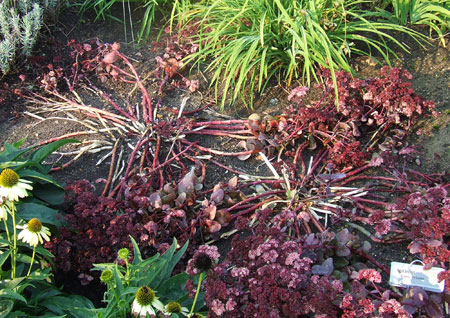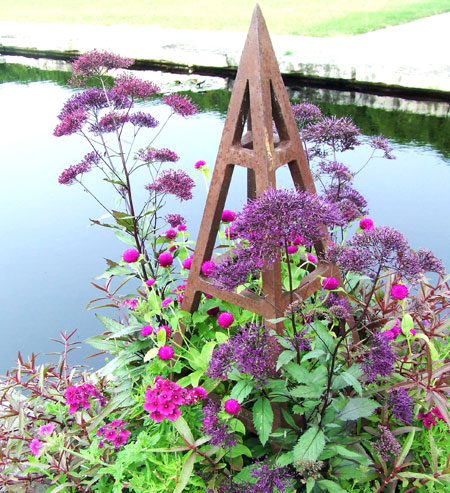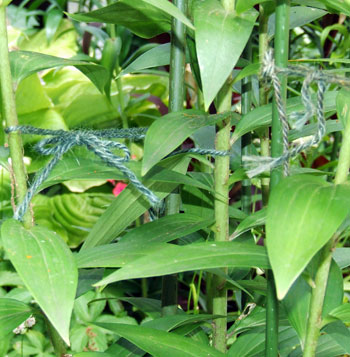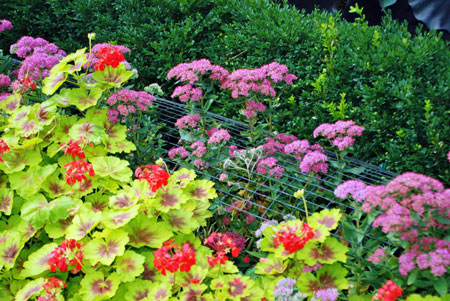For best appearances, stake large, heavy flowers
Floppy plants are the bane of the late-summer flower garden. Shore them up with supports.
Late summer can be a dazzling time in the flower garden, but as blooms surge in size, their stems may not be able to hold them up. Toppled dahlias, floppy sedum and broken Rudbeckia will end up making the garden look messy and cluttered. This is the time of year to be thinking about saving your fall display by providing some inexpensive supports to shore-up floppy plants.

Perennials with heavy flowers may grow leggy and flop over by
mid-summer. Photo credit: Rebecca Finneran, Michigan State University Extension
According to Michigan State University Extension, when grown in full sun, most annuals and perennials will stand up on their own. Over fertilization or shady conditions can get the best of plants that normally perform better with full sun exposure. Pruned (pinched) perennials seldom need staking because of increased branching, but plants that have heavy foliage such as Sedum ‘Autumn Joy’ or large blooms such as the Orienpet lily benefit from having a support for their robust foliage or individual blooms.
Bowing out
In a container, plants can be grown with supporting structures right in the pot. Ornamental obelisks and even clusters of twisted twigs make wonderful supports later on when plants want to bow out of the container, giving it an unkempt appearance.

Annuals can be grown in containers with an ornamental support
or bundle of twigs. Photo credit: Rebecca Finneran, Michigan State University Extension
Plant stakes are available to insert in a garden bed right next to a plant such as a top-heavy dahlia, lily or canna. Secure the plant using green jute twine or old pantyhose which will not bind plant stems. Be sure to secure the tie close to the top heavy bloom or the plant will topple over at the point of attachment and lower on the stem for stability. These supports can be temporary and removed after bloom, or stay in until frost.


Individual stems or heavy blossoms can also be supported with a single stake or twig and jute twine. Photo credits: Rebecca Finneran, Michigan State University Extension
Lean on me
Cannas and Dahlias may need supplemental support during the season, especially if they have been sited in windy areas. When a whole plant topples over, it often breaks, which can be disappointing. Plant these beauties in-between other substantial perennials or woody shrubs to allow them to “lean on” one another. Commercial wire cages or stakes may be necessary and are easiest to put on when the plants are small.
A more organic approach to staking is to harvest dormant, well-branched twigs from shrubs or small trees and insert them into the soil at the base of the perennial plants. As the plant’s foliage expands, the “twig supports” will be covered up, but allow for some “leaning” such as on a cane.
An easy approach for floppy plants is to employ garden fencing with 2-inch by 3-inch grid. You can make a cage that encircles the plant to keep it upright or you can simply form an arc over the top of the plants, allowing them to grow up through the mesh. The idea with any support is that when the plants are fully grown, the support will not be seen.

Simple use of garden fencing in this example forces the sedum to
grow up through it, supporting the heavy blooms later in summer.
Photo credit: Rebecca Finneran, Michigan State University Extension
For more information on a wide variety of smart gardening articles, or to find out about smart gardening classes and events, visit www.migarden.msu.edu and Finneran’s blog. You can contact the MSU Master Gardener Lawn and Garden Hotline at 888-678-3464 with your questions.



 Print
Print Email
Email

